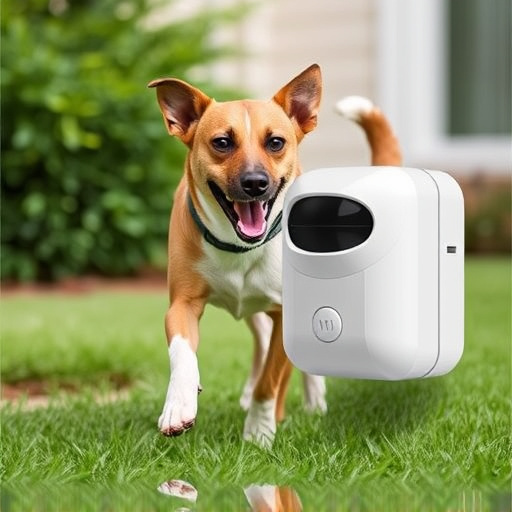The motion sensor barking dog alarm is a revolutionary pet safety solution that combines sensitive movement detection with the deterrent power of a dog's bark, enhancing home security without causing disturbance. This humane approach protects pets and homeowners from intruders, offering peace of mind through advanced technology and effective training methods. Installation is simple, involving strategic sensor placement and regular maintenance, while training pets to respond appropriately ensures optimal system performance.
“Revolutionize your pet’s safety with cutting-edge motion sensor technology. This article delves into the innovative world of pet alarm systems, specifically exploring the role of a barking dog alarm as a potent tool in pet protection. We’ll dissect the benefits and features of advanced systems, guide you through installation and maintenance, and offer crucial insights on training your pet to respond to alerts. Understanding motion sensor technology and its impact on pet safety has never been easier.”
Understanding Motion Sensor Technology: How It Works
Motion sensor technology plays a pivotal role in modern pet alarm systems, offering a sophisticated way to protect your home and keep your pets safe. These sensors are designed to detect any movement or changes within a defined range, triggering an alarm when unauthorized access is attempted. In the context of a barking dog alarm, the motion sensor is particularly effective at deterring intruders without disturbing nearby animals or neighbors with excessive noise.
At its core, a motion sensor bark alarm combines sensitive motion detection with advanced audio capabilities. When the sensor picks up on movement, it activates an alarm that can include both visual and auditory cues. The barking component is designed to mimic a dog’s warning barks, effectively scaring off potential intruders while alerting you or neighbors to any suspicious activity. This technology ensures your home remains secure, all while maintaining a humane approach by leveraging the natural instincts of a barking dog as a deterrent.
The Role of a Barking Dog Alarm in Pet Safety
A barking dog alarm, often equipped with advanced motion sensors, plays a pivotal role in enhancing pet safety within homes and gardens. Unlike traditional alarms that rely solely on glass-break or door/window sensors, this innovative system leverages the power of a dog’s natural bark to deter intruders. When an unauthorized person enters the premises, the motion sensor detects their presence and triggers a high-decibel bark, effectively scaring off potential threats before they can cause any harm.
The integration of a barking dog alarm offers several advantages. It provides peace of mind for pet owners, knowing that their furry companions are vigilant guardians. Moreover, it serves as a powerful deterrent against burglars, who often target homes with pets inside due to the added risk and noise. With its combination of motion detection and auditory warning, this pet safety system creates a comprehensive security network tailored to protect both pets and homeowners alike.
Benefits and Features of Advanced Pet Alarm Systems
Advanced pet alarm systems offer a multitude of benefits, enhancing both home security and the well-being of your furry companions. One of the key features is the integration of motion sensors, which detect any unwanted intrusions into your property. These sensors are particularly effective in triggering alarms when an unfamiliar entity enters the designated area, ensuring quick response times to potential threats.
Furthermore, these systems often incorporate barking dog alarms as a sophisticated deterrent. The loud and consistent bark simulated by these alarms can scare off intruders without causing harm. This feature is especially valuable for homeowners concerned about their pet’s safety during unaccompanied periods, as it provides an additional layer of protection against both human and animal intruders.
Installing and Maintaining Your Pet Alarm System
Installing a pet alarm system, particularly one that includes a motion sensor and barking dog alarm, is a straightforward process designed to be user-friendly. Most systems come with simple step-by-step guides and all necessary hardware. Typically, you’ll start by identifying the areas you want to protect, such as entry points or specific rooms. Next, securely mount the sensors in these locations, ensuring they’re out of your pet’s reach. These sensors are sensitive enough to detect movement without false triggers from passing animals or people.
Regular maintenance is key to keeping your pet alarm system reliable and effective. This involves checking battery life, testing sensors for any blockages, and updating software if available. Many modern systems offer remote monitoring and control via smartphone apps, making it easy to stay on top of maintenance and ensuring peace of mind, even when you’re away from home.
Training Your Pet to Respond to the Alarm Signal
Training your pet to respond to the alarm signal is a crucial step in implementing a successful pet alarm system, especially for those with barking dogs. Start by introducing the motion sensor and its sound to your pet in a controlled environment, away from any triggering events. This helps them associate the beep or bark of the barking dog alarm with a neutral situation, reducing potential fear or anxiety.
Gradually expose your pet to simulated movement, such as a family member’s shadow passing in front of the sensor, while the alarm is activated. Positive reinforcement, like treats or praise, can help condition them to recognize and ignore false triggers but respond appropriately when an actual motion is detected. Consistency is key; regular training sessions will ensure your pet learns to differentiate between real threats and harmless stimuli, fostering a calmer and more secure environment for everyone.
